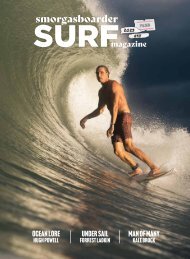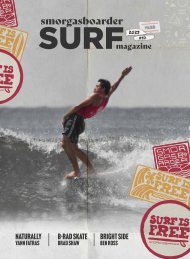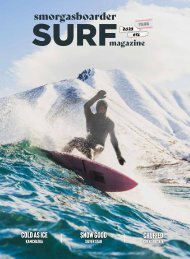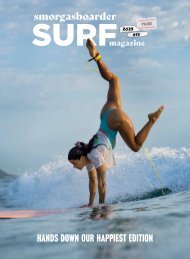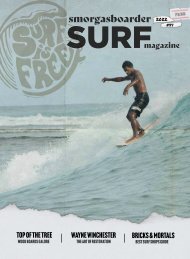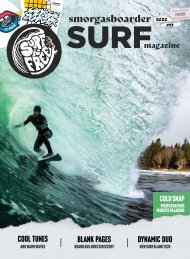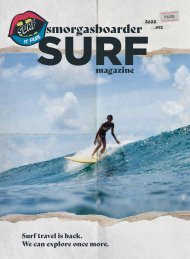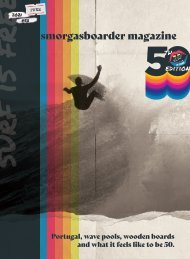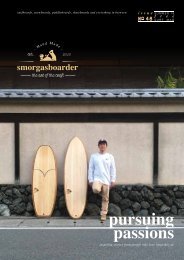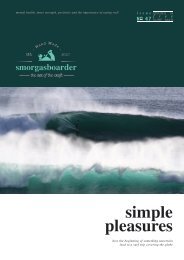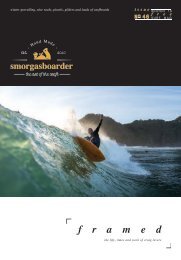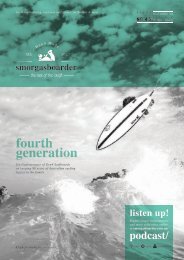SB-issue59_digital
Create successful ePaper yourself
Turn your PDF publications into a flip-book with our unique Google optimized e-Paper software.
gear<br />
Whilst chasing a career on the pro junior<br />
and QS (Qualifying Series) surf circuit, Dan<br />
McManus came to realise that his true passion<br />
lay in not just riding surfboards, but making<br />
them. His then relentless pursuit of a shaping<br />
career culminated in the formation of Mana<br />
Surfboards, based on the Central Coast of New<br />
South Wales. Dan’s focus is acutely honed in<br />
on crafting contemporary, high-performance<br />
custom blades, mixed equally with alternate<br />
performance designs.<br />
We recently caught up with Dan to discuss his former competitive days and<br />
how he first got his hands on a planer. Dan picks up the story.<br />
“I originally set out to be a pro surfer. I was doing the pro juniors for a<br />
while and then when it came to moving on to the QS level stuff, I came to<br />
the honest realisation that I was a terrible contest surfer. I just didn’t have<br />
the right mindset for top level competition. I competed from ’97 through<br />
to about 2004. So instead of continuing to pursue a career in surfing, I<br />
reluctantly headed off to university.”<br />
Dan undertook a degree in physical education. During this time, funnily<br />
enough, his surfing career underwent a resurgence, albeit in the world of<br />
free surfing and not in the competitive arena.<br />
“I ended up travelling a lot more. I got some sponsors and was surfing a<br />
lot in some amazing places. I was still doing regional boardriders, but the<br />
contest stuff took a back seat to free surfing.”<br />
Dan ended up finishing his university degree and starting his own traction<br />
pad company not long after, but the call of surfboard shaping was everpresent.<br />
“I was always shaping on and off. In the mid-90s, like a lot of groms, I<br />
was sweeping the factory floor of my surfboard shaper at the time — my<br />
sponsor, Karl Hassel at HPS Surfboards. I started there in late 1996, maybe<br />
‘97. I think I would have been about 13 years old.<br />
“I was the annoying grom who just wouldn’t leave him alone until he gave<br />
me a job. One day he just said, ‘Okay, well, here’s a broom.’ The place<br />
probably hadn’t been swept in about five years. So, I cleaned the entire<br />
factory forensic-style from top to bottom until I couldn’t clean anymore.<br />
I guess he thought to himself, ‘Okay, this kid is not going to go away, so<br />
here’s a whole room of rescue boards that are just absolutely destroyed.’”<br />
As Dan explained, those boards are big enough that, once you get your<br />
head around using epoxy, they’re pretty hard to make a mistake with. So,<br />
he became the ‘rescue board ding guy’ for a while.<br />
“Once I got through all those, Karl showed me another door with all of<br />
his ding repairs. The room was full of hundreds of them. I guess that was<br />
the start of really understanding board building. I had to reconstruct and<br />
reshape a lot of damaged boards. I saw a lot of curves, foils, and outlines,<br />
and exposed myself to a world of different shapers and designs.”<br />
With such a volume of work, Dan honed his skills in surfboard ding repair<br />
quite rapidly, but he was still chomping at the bit to shape.<br />
“Karl was a master craftsman, and he was one of the most sought-after<br />
contract glassers in the late 90s and early 2000s. We were doing a lot of<br />
boards for guys like Rex Marechal (RMS) and Justice Surfboards from<br />
Japan, and I just wanted to progress my skills. So, I was always bugging<br />
Karl to shape, but he insisted I needed to develop all the skills of board<br />
building first. He was like Mr Miyagi.”<br />
Dan progressed from dings to inserting leash and fin plugs, filler coats, and<br />
lamination, which are all part of the surfboard construction process. The<br />
missing ingredient, however, continued to be his holy grail of mowing foam<br />
— learning how to shape a surfboard blank.<br />
“It was really funny. He was always like, ‘No, no, no, I’ve got to get through<br />
this last bit for you first.’ And, being an impatient kid, I just didn’t want a<br />
bar of it. I think I had been there for two and a bit years by that stage.<br />
“I ended up finishing with Karl, but I really appreciated the start that he<br />
gave me. Anyhow, the work side of things took a back seat for a little bit<br />
while I focused on competitive surfing.”<br />
# 59 // smorgasboarder //<br />
83



